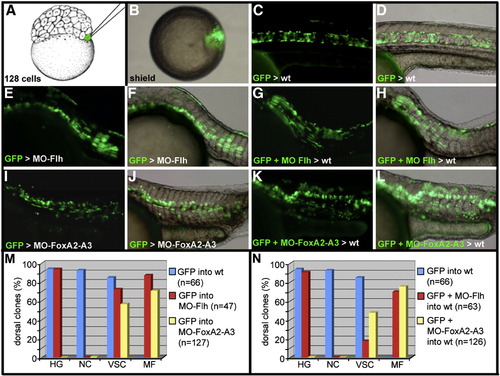Fig. 7
- ID
- ZDB-FIG-110224-13
- Publication
- Dal-Pra et al., 2011 - FoxA transcription factors are essential for the development of dorsal axial structures
- Other Figures
- All Figure Page
- Back to All Figure Page
|
Cell-lineage analysis of dorsal midline progenitors. (A–D) Schematic representation of the cell-lineage strategy. (A) One marginal blastomere of a 128-cell stage embryo is injected with GAP-gfp RNA. (B) At early gastrula stage, embryos displaying the GFP positive cells within the embryonic shield are isolated. The fate of the labeled cells is analyzed at 24 hpf. (C and D) In wild-type embryos, GFP positive cells populate only the axial structures and the dorsal periderm. (E–H) Dorsal marginal cells labeled with GFP and depleted of Flh activity differentiate into muscle fibers and floor plate in Flh morphant embryos (E and F) and in wild-type embryo (G and H). (I–L) Dorsal marginal cells labeled with GFP and depleted of FoxA2 and FoxA3 activities participate in the formation of muscle fibers and cells of the ventral neural tube in FoxA2–FoxA3 morphants (I and J) and in wild-type embryos (K and L). (M and N) Quantitative analysis of the repartition of the GFP-labeled cells in the hatching gland (HG), notochord (NC), ventral spinal cord (VSC) and in muscle fibers (MF), when they differentiate in a morphant (M) or wild-type environment (N). (A) Lateral view, anterior up. (B) Animal pole view, dorsal to the right. (C–L) Lateral views, anterior to the left. |
Reprinted from Developmental Biology, 350(2), Dal-Pra, S., Thisse, C., and Thisse, B., FoxA transcription factors are essential for the development of dorsal axial structures, 484-495, Copyright (2011) with permission from Elsevier. Full text @ Dev. Biol.

